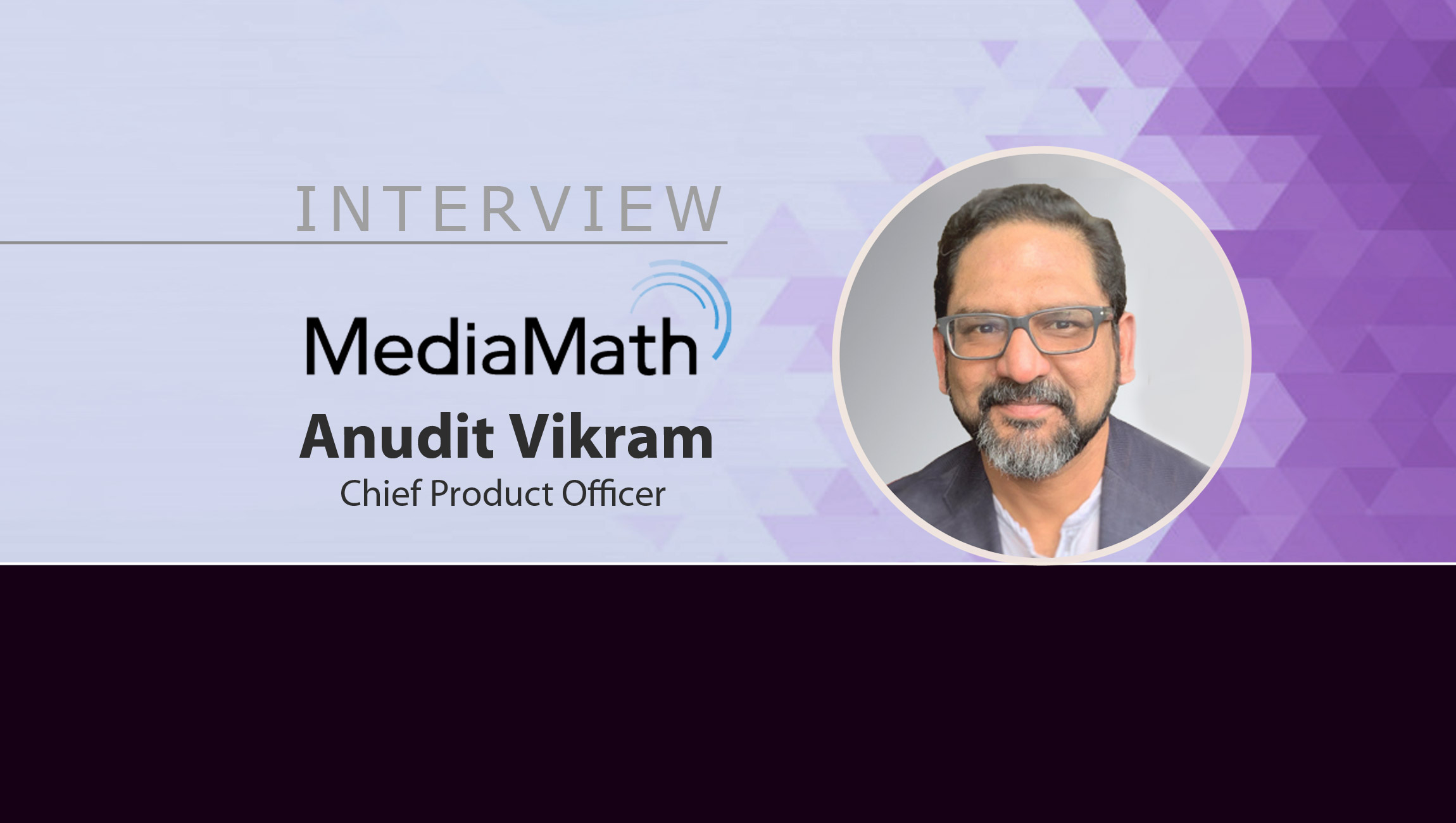With the market dynamics for ad spends, ad buying and use of adtech rapidly shifting to take on more targeted and precision-based approaches, there are a lot of synchronizations still needed between marketers and advertisers to drive improved revenue; Anudit Vikram, Chief Product Officer at MediaMath has some tips to share:
______
Welcome to this MarTech Series chat Anudit, tell us more about yourself and your journey through the years?
I’m happy to be taking part in this interview! I started as an engineer in my early career working with Novell, the company often touted as starting computer networks, and Microsoft. During my time at Microsoft, it was my job to evangelize the company’s server products. My time at Novell was a blast as well – the ‘shock and awe’ effect of technology in the early 90s is something that can’t be recaptured. As my career progressed, I had the privilege of working with some amazing teams across Yahoo!, Merkle, Dun and Bradstreet – and now MediaMath. My journey in the marketing and MarTech space dates to the early/mid-2000s and it’s been a pleasure to be able to combine that experience with that of the rest of MediaMath’s leadership team.
How have you seen digital marketing technologies and digital marketing trends evolve during this time in the industry?
I have been lucky enough to have had a ringside view into the evolution of marketing into the digital-first mode it has become today. We have come from a place of fully guaranteed media to programmatic buying; from flat fee to dynamic pricing; from spray and pray approach to hyper-targeting advertising; from aggregate measurement to down at the bid level. We are at a point where the marketer has great control over the execution and measurement of their campaigns. All of this has been possible because of the maturation of technologies – even the birth of brand-new tech. And it is all still evolving. I am excited about what the future will bring and proud to be a part of building it.
Marketing Technology News: MarTech Interview with Lisette Huyskamp, CMO at Productsup
Can you share your thoughts on the impact current business and world dynamics are having on the typical B2B marketing media mix and how you are especially seeing a renewed interest in CTV today?
The market dynamics of TV have rapidly changed particularly since the beginning of 2020. Global shutdowns in response to the COVID-19 pandemic created a much more rapid surge in growth for streaming services, that were already steadily growing as younger generations and demographics chose streaming platforms over traditional TV and cable. With CTV grabbing a bigger and bigger portion of the spotlight and emerging as consumers’ platform of choice, advertisers are having to quickly reshape budgets and strategies to reach audiences in new ways. The careful ad planning of the past will continue to shift to the accelerated speed of CTV ad buying. We’ve now reached a tipping point where marketers can no longer afford anything but complete visibility into audiences and metrics no matter the channel. They must devise new tactics to measure success as more globally broadcast content becomes available on streaming platforms. This is a key reason why we designed the SOURCE framework at MediaMath, creating a new approach to media buying (including CTV) that provides an addressable, accountable, and transparent supply chain for the industry.
As streaming services pick up the attention of marketers, in what ways do you feel marketing teams who aren’t focusing on these channels can capitalize on this trend more?
My first piece of advice would be to start focusing more on these channels. Look to make them a more common piece of your advertising strategy as you’re missing out on key audience demographics by not doing so. For example, Millennials and Gen Z make up a large portion of today’s ‘cord cutters’ – opting for various streaming services rather than paying for traditional TV. By not having a plan of action for CTV in your ad strategies, you’re likely not breaking into these age groups as much as you can. Of course, if this isn’t your demographic, it’s less of a need, but streaming is taking more of a center stage overall, so attention needs to be paid. The recent Olympic games in Tokyo are prime example of why marketers should get more involved with these channels. According to NBC, more than 4.3 billion minutes of content were streamed from the Tokyo event – up 22% from the 2016 games in Rio and up 95% from the 2018 games in PyeongChang. We’re seeing a clear shift to streaming from the more traditional, linear models of TV. Today’s marketers would be remiss not to place ad dollars on CTV, at the very least during key, global events such as the Olympics, World Cup, etc.
What are some immediate thoughts you’d like to highlight surrounding the future of CTV and media marketing?
In the next year, I predict we’ll see an enhanced focus on measurement and attribution as advertisers continue to spend top dollar for CTV ad space, and as they seek to gain deeper understanding into ad performance, like they were accustomed to in a Linear TV market. There is also going to be a tighter collaboration between the publisher and buyer communities to really solve for identity and frequency management. We’ve revamped our own identity graph this year with added partners for scale, to not only solve identity and performance challenges, but empower advertisers to apply audience data and frequency controls to avoid the over messaging that is happening across connected TV and OTT devices.
The bottom line is TV viewing simply isn’t what it used to be – our attention is fragmented. Advertising won’t go back to where it was pre-pandemic. Streaming and CTV will continue to expand, muscling out linear TV and becoming a top arena for marketers and advertisers to reach their target audiences.
Marketing Technology News: MarTech Interview with Einat Etzioni, CMO at Namogoo
A few thoughts on the future of martech and B2B marketing? Some top skills you feel marketing leaders need to strengthen in today’s environment?
The future is bright. B2B marketing has been undergoing a revolution with the advent of technologies which allow us to capture and use data at the company level but measure it at the individual level. This has led to increased complexity in the way marketing strategies can be carried out. A leader today needs to have a good mix of the creative and technical elements. They should be able to understand various technologies while and see how they can be best used in the channels where they expect to find their customers. Customers are becoming increasingly aware of their own power and the marketer must acknowledge that and work with them.
 MediaMath is an acclaimed independent advertising technology company for brands and agencies.
MediaMath is an acclaimed independent advertising technology company for brands and agencies.
Anudit Vikram is a business and technology leader with over 20 years of experience, largely in the advertising and technology industries. As the Chief Product Officer of MediaMath, Anudit oversees the company’s entire suite of offerings and is tasked with leading MediaMath’s world-class product team in bringing its product vision to life. Prior to MediaMath, Anudit served in leadership positions at Dun & Bradstreet, Mekle, Yahoo!, Microsoft and other noteworthy organizations, leading teams and “building cool stuff… changing the world one release at a time!” Anudit holds a Master’s in Technology Management from Columbia University, and a bachelor’s in engineering from the University of Pune (India).
Catch the latest B2B Marketing and Sales Conversations with these latest episodes of The SalesStar Podcast!
Episode 93: How Do You Build An Impactful Customer Success Model: With Daljit Bamford, Tenth Revolution Group
Episode 92: B2B Marketing Learnings And Martech Tips With Jon Perera, CMO At HighSpot
Episode 91: Top Trends And Concerns Of B2B Revenue Teams: With Sylvia Ananicz, Head Of Revenue At Lilt











